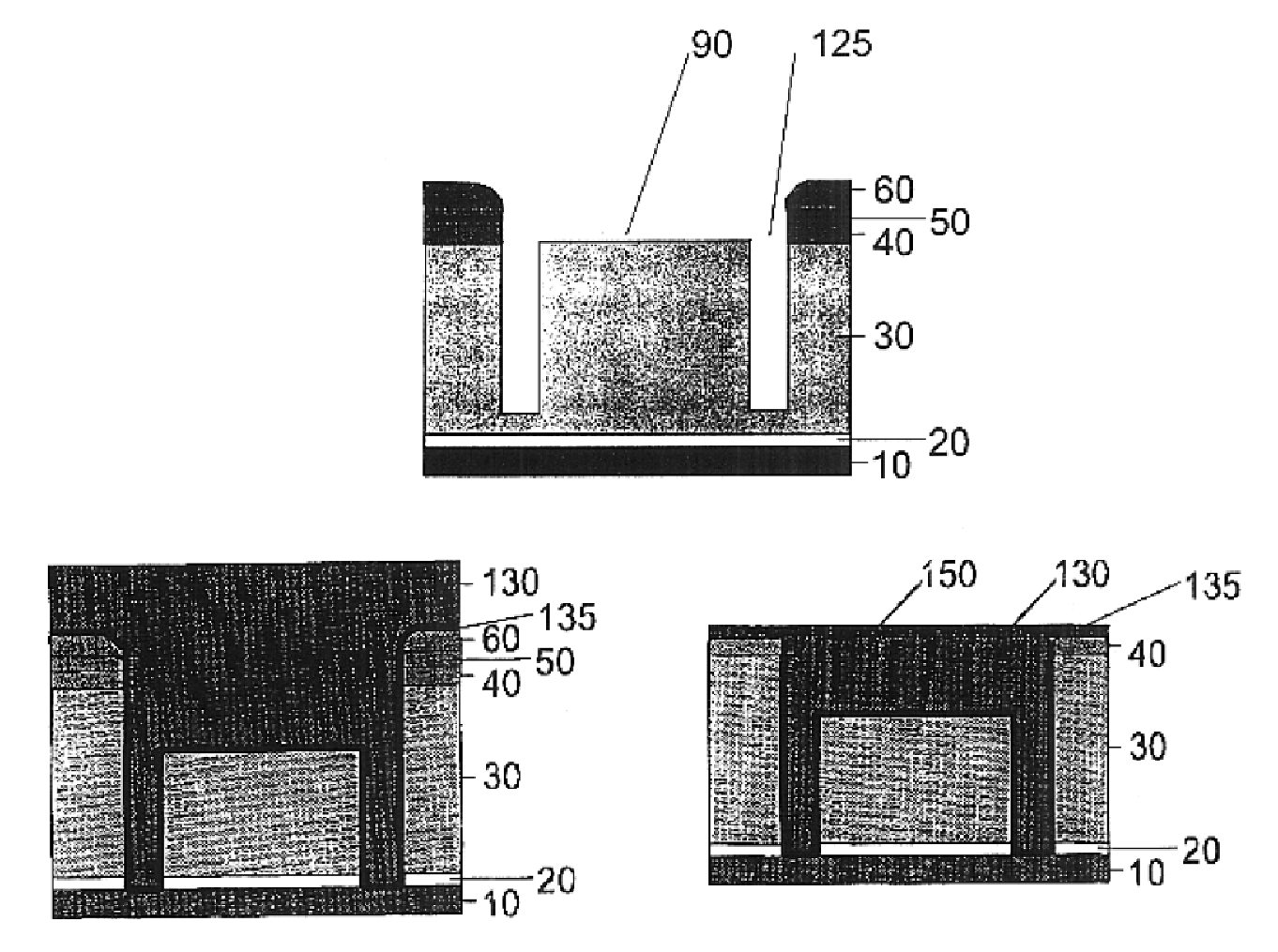Protective hardmask for producing interconnect structures
a protective mask and interconnect technology, applied in the direction of semiconductor devices, semiconductor/solid-state device details, electrical apparatus, etc., can solve the problems of affecting the production efficiency of interconnect structures
- Summary
- Abstract
- Description
- Claims
- Application Information
AI Technical Summary
Benefits of technology
Problems solved by technology
Method used
Image
Examples
first embodiment
the present invention is depicted in FIGS. 1-10 comprising a dual damascene structure having a triple layer hardmask. A silicon semiconductor substrate 10 has deposited thereover an etch stop layer 20 comprising, for example, amorphous hydrogenated silicon carbide preferably that sold under the tradename BLoK.TM. by Applied Materials of Santa Clara, Calif. The thickness of etch stop layer 20 is preferably from about 10-100 nm, with a thickness of 50 nm being more preferred. Etch stop layer 20 ideally has the combined properties of not only being an etch stop layer but also a diffusion barrier to subsequent interconnect materials such as copper.
Etch stop layer 20 may also include such materials as silicon nitride, silicon carbide nitride, organo-silicate glass (OSG), silicon rich oxide (SiRO), silicon dioxide, organic siloxane polymer, carbon or hydrogen doped silicate glass or silsesquioxane glass, spin-on glass, fluorinated or non-fluorinated silicate glass, or any material know in...
third embodiment
the present invention is depicted in FIG. 13 comprising a dual damascene structure having a bi-layer hardmask. The structure of FIG. 13 is similar to the structure of FIG. 1 except that the first low dielectric constant hardmask layer 40 is omitted. Fabrication proceeds in a manner similar to that described in connection with FIGS. 1-10 except that conditions for the CMP process are chosen such that hardmask layer 60 is removed while leaving hardmask layer 50 permanently in the structure. This structure has many advantages over structures known in the prior art and allows for the use of organic bulk low-k ILD 30 while providing tolerance for overlay errors, lithography rework capability, high performance, low cost and physical construction feasibility. In this embodiment the preferred bi-layer hardmask comprises PECVD silicon nitride with a thickness of about 35 nm (hardmask layer 50) and PECVD silicon dioxide layer with a thickness of about 150 nm (hardmask layer 60).
fourth embodiment
A fourth embodiment is depicted in FIG. 14 comprising a dual damascene structure having a bi-layer hardmask further including an embedded etch stop layer similar to the structure shown in FIGS. 1 and 13. As in FIG. 13, a low dielectric constant hardmask layer 40 is omitted. However, similar to FIG. 11, the bulk low-k ILD is comprised of two sections, a lower ILD 32 and an upper ILD 36 separated by embedded etch stop layer 34. Patterning proceeds identically to that discussed previously except that again hardmask layer 60 is removed while permanently retaining hardmask layer 50 in the final structure.
In a fifth embodiment comprising a single damascene structure with a triple layer hardmask, FIG. 15 illustrates a structure similar to the dual damascene structure of FIG. 1 except that bulk low-k ILD 30 now has a thickness of a desired line-level, and the etch stop layer 20 is optional. A photoresist layer 80 is patterned and etched, the pattern of which is etched into third hardmask la...
PUM
 Login to View More
Login to View More Abstract
Description
Claims
Application Information
 Login to View More
Login to View More - R&D
- Intellectual Property
- Life Sciences
- Materials
- Tech Scout
- Unparalleled Data Quality
- Higher Quality Content
- 60% Fewer Hallucinations
Browse by: Latest US Patents, China's latest patents, Technical Efficacy Thesaurus, Application Domain, Technology Topic, Popular Technical Reports.
© 2025 PatSnap. All rights reserved.Legal|Privacy policy|Modern Slavery Act Transparency Statement|Sitemap|About US| Contact US: help@patsnap.com



